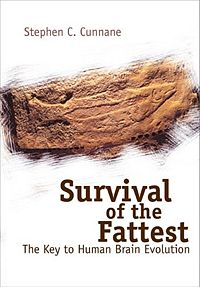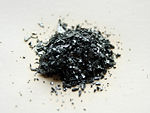Survival of the Fattest: Difference between revisions
imported>Brian R. Head No edit summary |
imported>David E. Volk m (→Brain Selective Nutrients: capitalization of page names removed) |
||
| Line 24: | Line 24: | ||
===Brain Selective Nutrients=== | ===Brain Selective Nutrients=== | ||
In association with proper food intake for adequate gluconeogenesis/ketogenesis, the natal and post-natal brain needs certain nutrients for normal brain function. The term [[Brain Selective Nutrients]] was coined by Dr. Cunnane et al. in 1993. <ref name=Cunnane1993.> Cunnane SC, Harbige LS, Crawford MA. The importance of energy and nutrient supply in human brain evolution. ''Nutr Health 9'', 219-235, 1993.</ref> Brain selective nutrients have an irreplaceable role in the critical periods of brain development. Some Brain selective nutrients are: [[ | In association with proper food intake for adequate gluconeogenesis/ketogenesis, the natal and post-natal brain needs certain nutrients for normal brain function. The term [[Brain Selective Nutrients]] was coined by Dr. Cunnane et al. in 1993. <ref name=Cunnane1993.> Cunnane SC, Harbige LS, Crawford MA. The importance of energy and nutrient supply in human brain evolution. ''Nutr Health 9'', 219-235, 1993.</ref> Brain selective nutrients have an irreplaceable role in the critical periods of brain development. Some Brain selective nutrients are: [[iodine]], [[docosahexaenoic acid]], [[iron]], [[copper]], [[zinc]], and [[selenium]]. | ||
====Iodine==== | ====Iodine==== | ||
Revision as of 15:09, 7 April 2008
Articles that lack this notice, including many Eduzendium ones, welcome your collaboration! |
THIS IS AN ACITVE STUDENT PROJECT THROUGH A SPECIAL UNIVERSITY OF COLORADO PROJECT PLEASE REFRAIN FROM EDITING. THANK YOU
Survival of the Fattest: The Key to Human Brain Evolution was written by Stephen C. Cunnane. The book outlines why fat babies are important to human brain evolution and the ecological circumstances that allowed for fat babies to evolve. Cunnane details the specific nutrients that are important for human brain growth and function and explains the ways in which they work. Cunnane also presents a theory called the Shore-Based Scenario to explain where ancient hominids obtained these nutrients. The book has implications for many fields such as: Neurophysiology, Biological Anthroplogy, Paleoanthropology, Paleoecology.
Synopsis
The Human Brain
Cunnane begins by explaining the similarities of all animal brains. Hox genes control the traits of brains for almost all animal species. Similar to all primates, humans don’t show a specific genetic advantage for brain growth while in the early stages of embryonic development. [1] He describes the uniqueness of the human brain as having low resistance to damage, low functionality at birth, yet being incredibly vulnerable and needing a constant energy supply to develop normally. The newborn infant brain uses about 74% of the energy consumed by the entire body. Cite error: Invalid <ref> tag; invalid names, e.g. too many A basic question, central to any hominid brain evolutionary theory, is posed: Where could ancient hominids obtain the high metabolic energy that is needed for brain development?
Cunnane describes a phenomenon called critical periods of progressive neurological developmental periods. If any of these critical periods are interfered with, the developing brain will become vulnerable to all kinds of Brain Damage. The brain needs a constant supply of brain selective nutrients to develop normally. These critical periods happen before the baby is born as well as during the first years of infancy. Ultimatley, infants who have a poor diet are extremely vulnerable to have permanent mental retardation.
The human brain uses primarily glucose to function. [1] However, the brain needs backup fuel requirements called Ketone Bodies that form during fatty acid oxidation. Ketones are important during periods of starvation when glucose levels in the blood drop. Cunnane hypothesizes that in order for the human brain to get larger, humans had to evolve a larger extent to make ketones that come from greater fatty acid reserves—e.g. fatter babies.
Brain Selective Nutrients
In association with proper food intake for adequate gluconeogenesis/ketogenesis, the natal and post-natal brain needs certain nutrients for normal brain function. The term Brain Selective Nutrients was coined by Dr. Cunnane et al. in 1993. [2] Brain selective nutrients have an irreplaceable role in the critical periods of brain development. Some Brain selective nutrients are: iodine, docosahexaenoic acid, iron, copper, zinc, and selenium.
Iodine
Iodine is perhaps the most important brain selective nutrient. Iodine does not directly effect the brain, but it plays a major role in the Thyroid gland. With sufficient amounts of dietary iodine intake, the thyroid produces two hormones called thyroxine and triiodothyronine and collectively called thyroid hormone. Thyroid hormone acts in several different ways in the body, but Cunnane emphasizes its role in natal brain development. Without dietary intake of iodine the thyroid cannot produce hormones and can lead to hypothyroidism or clinical hypothyroidism. Clinical hypothyroidism is usually referred to as endemic cretinism and in infants has a high chance of causing mental retardation. During natal development thyroid hormone plays a central role in brain development. Scientists, however, have much to discover to exactly how thyroid hormone’s role in brain development works. Iodine cannot be sustained in the body for very long. In other words the body cannot store it for use longer down the road. Therefore, iodine must be steadily supplemented in the diet for normal thyroid function to occur, and in infants it is crucial for a constant iodine intake.
In terms of evolutionary significance, sometime in human history humans have clearly evolved a dependency on iodine for proper brain and body function. Cunnane believes this dependency started prior to H. habilis. Ecologically, iodine is hard to find in significant amounts in the savannah environment. Iodine is easy to find when eating foods near and in a shoreline environment. Such foods as eggs, frogs, turtles, spawning fish, clams, crabs and mussels, all have high amounts of iodine in them.

